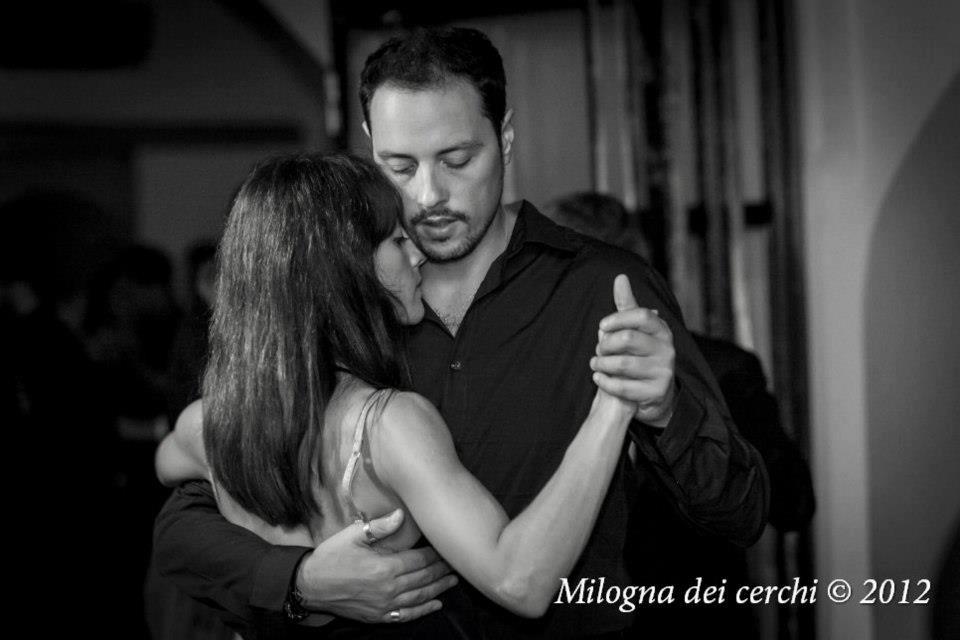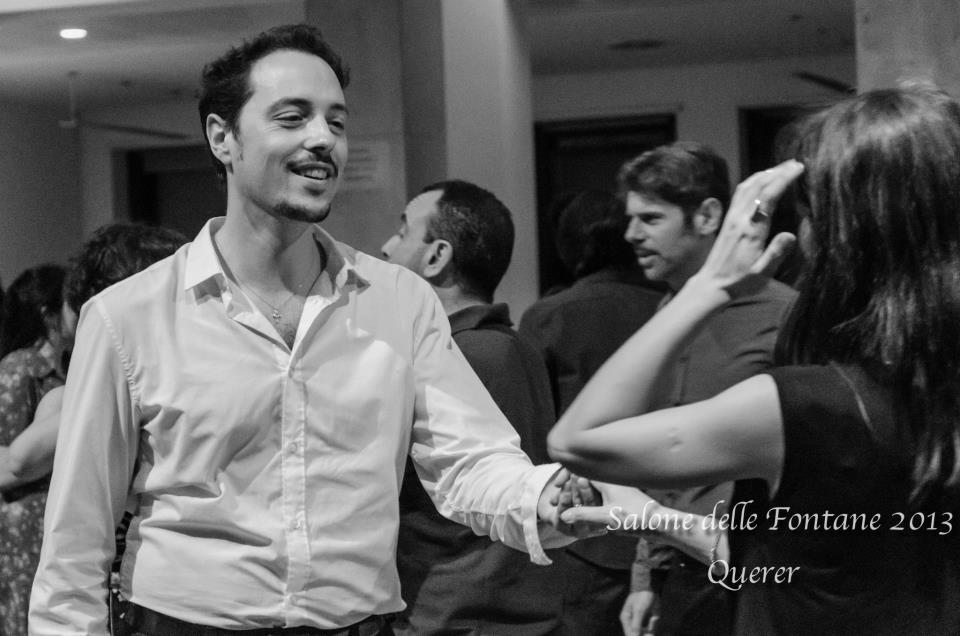
14 dec Intervju: Gianfranco Pernice
Italijani su vrlo energični, strastveni i topli ljudi. Gianfranco Pernice je tangeros iz Rima. Upoznala sam ga na
jednom internacionalnom festivalu u Poreču. Inženjer je po struci, a plesom se bavi iz hobija i zabave. Često putuje. Na tim putovanjima se uvek nađe poneka milonga koju poseti i otpleše po neku tandu.
How long have you danced?
I’ve danced tango for 4 years. It all started as a joke. I was with a friend of mine and one night I decided to go with her, just out of curiosity.
What inspired you to dance tango?
In the beginning, it was just curiosity – I wanted to see what other people only told me about, but when I started it was like a drug! I wanted to dance every day, so I went to the lessons with an open mind and a great intention to understand. Day by day, I saw my body moving in a better way, in accordance with music and, of course, my sensation and feeling.
How are the tango scene and community in Italy and how often do the dance nights (milongas) occur?
I live in Rome and I don’t have much direct experience with other communities, but I can see through social networks that new locations emerge every day and more and more people are connecting to share the really good experience of dancing. During the last three years here in Rome, the number of milongas rapidly increased, as well as the number of new Tango Teachers. I like that because there are a lot of different locations and we can choose where we want to go dancing. But on the other hand, I sometimes have the feeling that the real tango spirit is being replaced with a commercial and remunerative way to do business, but (thank God) not all the people and milongas organizers are focused on earning money and a lot of places are organized just to convey the real tango culture (i.e. respecting the “ronda”, respecting the right way to invite a woman to dance, using “Mirada” and “Cabeceo” and so on…)
Tell us about your experience in Argentina.
I was in Argentina, in Buenos Aires, two years ago. I stayed there for ten days during June. I took this trip with my brother (he doesn’t dance tango, but he was happy to come with me). It was an amazing experience. It was my first time in Argentina (and the last one, for now). It was like being in a dream: I felt scent of Tango everywhere – it was all around me (maybe because my first intention was to understand and to stay in the place where Tango was born)! Of course, not all the people dance tango in BsAs, but for someone who is looking for this kind of experience it is like being in a Disney World is for a child. The first thing that I felt was the warmth of the people, their openness and availability. Their culture is similar to ours, and the relationship with other people, as well as with foreigners, is often direct and friendly. I had planned to visit some places, so during the mornings we visited the city, the most important monuments and “barrios”. It is a big city, but it’s easy to go sightseeing by taxi or subway. It is very rich with interesting places and every barrio has its particularity. We were in the Barrio of Palermo – it is the largest barrio in BsAs. It is a residential place with beautiful gardens (I visited the Japanese Gardens. I recommend you to visit it.) and it is very safe and peaceful place. There are a lot of other interesting barrios, like El Boca (including “el caminito”, how can you not know the famous song?!) with the colored houses. It’s very typical, but also very touristy place. The other barrio that I liked was San Telmo, with the famous market. I usually went to the Tango school in the afternoon. I didn’t want to miss the opportunity to learn Tango in BsAs: there are a lot of schools owned by the most prominent tango dancers. Unfortunately, many of them are abroad during the winter, so you have to have a bit of luck! I remember well and with a certain emotion the practice taken in the Sunderland by Carlos Perez and his wife: it was fantastic! It was a very “simple” lesson, based on the most important thing in the tango dance: the walking! I’ll never forget the importance of this one for me. During the night there were a lot of milongas where you could go dancing: from the most traditional to the informal ones. I liked moving from one to another during the night and ending the night with Viruta, of course! In this Milonga I met some good people (both men and women) and also some other Italians who were living my very own dreams! I remember my first time in a BsAs milongas: I was in the “Porteno y Bailarin”, all the people were very elegant. Those are traditional milongas, where the focus is on the “respect” for the dancers, for the rules and, of course, for the “Tango”. I didn’t dance much, just one or two Tandas: I was fascinated by the environment and I spent entire evening looking around and feeling the atmosphere! The only remark that I have is that ten days were just not enough and they passed too quickly.
How often do you go to tango events and what do you like most in tango community?
I try to go dancing at least once a week (apart from the lessons, of course). In Rome there are some important tango events during the year, more or less three or four among Festivals, Marathons and so on. So I’m pretty lucky because I don’t have to take long journeys. But I like travelling and meeting new people a couple of times a year, or at least once. I like going outside Rome. I prefer abroad. What I like is the feeling of “familiarity” you can almost “touch”. I like seeing familiar faces again at the important Tango Festivals – faces of the people I’ve already met during the last editions or at some other Tango Events. This kind of “sociality” is a very important aspect for me, since the nature of my job requires travelling abroad. And I take my Tango shoes with me when I go away, because I know that somewhere there I can find a place to dance and put aside the homesick blues.
How regularly do you practice tango and how long does it take to get good at dancing?
I dance at least once a week, but I don’t see dancing as a sport or going to the gym to lose weight. I dance because I like it. I take Tango lessons twice a week in two different tango schools. I like to have different points of view when I am learning something new and I think I can capture the different aspects of this dance and of this kind of life in that way. I have no idea what is the minimum amount of time required to practice before you can call yourself a good dancer. I think there is something to learn every day and I don’t think there is an evaluation measure of a good dance level, except for maybe the feeling between you and your partner.
How do you feel about tango dancing?
During these years of dancing tango I have gone through some various and essential experiences, starting off with the embarrassment and ending up with the feeling of belonging to a good and strong community. I think that Tango is not just a dance, it is something more. Dancing can help you improve yourself, and I’m not talking here only about physical abilities, but about the personality, too. With its rules and its tradition, this kind of dance can alter the person. I’ve met some significant people and enlarged the circle of my friends. Tango is a way of socialization for me.
It is said that non-verbal communication and compatibility between you and your partner is very important in dancing tango. According to you, what makes two people compatible?
Dancing is, of course, a non-verbal communication and in my opinion, you should open your heart to your partner. You cannot dance pretending you are someone else because your emotions, feelings and your mood inexorably show up. You cannot simulate dancing and this is why it is very important to relate to your partner. You will know when it happens: you won’t be thinking about the steps or the partner, music will guide you both and you will be following it at the same time in the same way. It is quite a sensation knowing that all the bricks in the dance wall are in place: you and your partner become one thing. It sometimes happens that you and you partner are not in accordance but fortunately, it happens rarely!
What kind of a woman inspires you and makes you ask her to dance with you?
An interesting question, because I sometimes ask myself after a Tanda “Why did you dance with her?!” I don’t have a female dancer stereotype to follow, but generally I decide to dance with someone because I think they could be a good experience. First of all, I try to find out if they are good dancers or not: their tango level is important. I like to give and receive a good sensation and if I have to spend all the Tanda trying to stay in equilibrium because they are not able to dance, then, of course, I prefer doing something else, i.e. talking a bit! To be honest, I have to say that the physical aspect is also important, but not at the first step. I try to understand what kind of person I am dealing with and whether I like them or not. I’ll try to explain: I like sunny people, “funny” women, so the woman I would like to dance with should be this kind of a person. If she is smiling, it is a good starter point!
Describe briefly your dance style and the way you see and feel the tango.
I don’t know exactly what is my tango style. Of course, I am learning Tango Salon, but defining my style is difficult. Maybe one of my Tango partners could come up with a better reply. It is easier to describe how I feel when I dance than to describe my style. When I dance I feel free and able to express myself. It is a good sensation. I also like to play with a partner and joke around with particular steps. So if I had to say what is my style, I’d say that my tango is a mirror to my soul! I suppose my tango is my mirror: in my real life I am a positive person who likes having fun, playing and laughing, but I’m also serious and passionate. So my dance is kind of like that: fun, but passionate, too. I like to spread good feelings and I am generous when it comes to that, but I also like to receive the same attention from the others. Tango is an exchange of emotions for me.
Marina Mićanović
Zahvaljujemo se Tanji Spasojević za lekturu 🙂 Našoj dragoj Marini Mićanović na uloženom trudu i energiji i Gianfrancu na strpljenju 🙂




Nema komentara